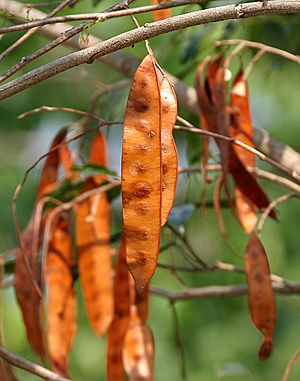Albizia facts for kids
Quick facts for kids Albizia |
|
|---|---|
 |
|
| Persian silk tree (Albizia julibrissin), foliage and blossoms |
|
| Scientific classification |
|
| Kingdom: | Plantae |
| Clade: | Tracheophytes |
| Clade: | Angiosperms |
| Clade: | Eudicots |
| Clade: | Rosids |
| Order: | Fabales |
| Family: | Fabaceae |
| Clade: | Mimosoideae |
| Genus: | Albizia Durazz. 1772 |
| Diversity | |
| About 150 species | |
| Synonyms | |
|
|
Albizia is a group of over 160 types of trees and shrubs. They grow mostly in warm, tropical and subtropical parts of the world. These plants are part of the pea family, Fabaceae. You can find them all over the world in warm areas, especially in Asia, Africa, and Australia.
People often call them silk plants, silk trees, or sirises. The name Albizia comes from an Italian nobleman, Filippo degli Albizzi. He brought the Albizia julibrissin to Europe in the mid-1700s. Sometimes, people mistakenly call them "mimosa," but that name belongs to a different group of plants.
Contents
What Do Albizia Plants Look Like?
Most Albizia plants are small trees or shrubs. They usually do not live for a very long time. However, there is a huge Albizia saman tree in Venezuela called the Samán del Guère. It is hundreds of years old!
Leaves and Flowers
Albizia leaves are special. They are made up of many smaller leaflets, like a feather. This is called "pinnately compound" or "bipinnately compound."
The flowers are small and grow in bunches. The most noticeable part of the flower is its many long, colorful stamens. These stamens are much longer than the petals. They often look like fluffy pom-poms. For example, the Persian silk tree has beautiful pink stamens.
Albizia flowers have more than 10 stamens. This helps tell them apart from Mimosa flowers. Also, Albizia stamens are joined at their bases. This is different from another related group of plants called Acacia.
How Are Albizia Plants Used?
Albizia plants are very useful. They provide food for animals, especially forage (plants eaten by grazing animals). Their wood is also used as timber. Some species are even used in traditional medicine.
Many Albizia trees are grown just for their beauty. Their pretty, fluffy flowers make them popular ornamental plants in gardens. The Albizia julibrissin is a great example of this.
Food for Caterpillars
Some Albizia species are also food for the larvae (young forms) of certain moths. These include moths like E. damor and E. malabaricus.
Albizia as an Invasive Plant
Some Albizia species can become invasive. This means they grow very fast and spread easily in new places. When they spread too much, they can harm the local environment.
For example, the Molucca albizia (Falcataria moluccana) is a problem in Hawaii and other Pacific Islands. It grows quickly in wet areas. This tree also tends to drop large branches. These falling branches can damage power lines, houses, and other buildings.
See also
 In Spanish: Albizia para niños
In Spanish: Albizia para niños


